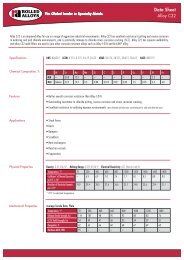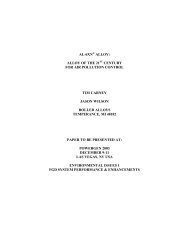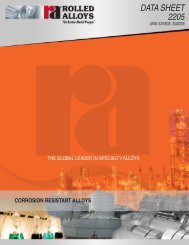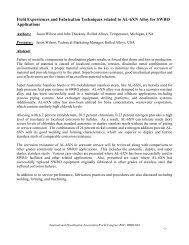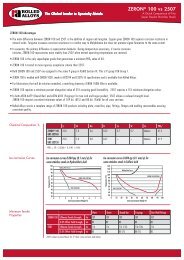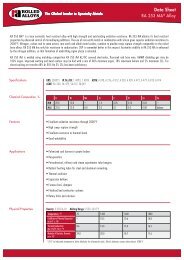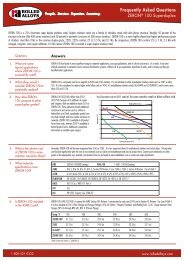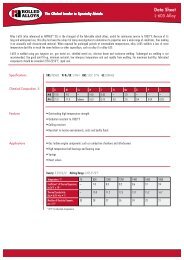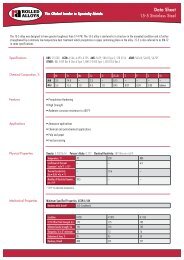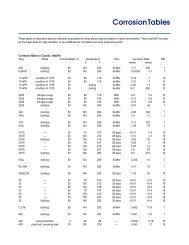Molten Metals [Heat Resistant Alloys (Environments)] - Rolled Alloys
Molten Metals [Heat Resistant Alloys (Environments)] - Rolled Alloys
Molten Metals [Heat Resistant Alloys (Environments)] - Rolled Alloys
Create successful ePaper yourself
Turn your PDF publications into a flip-book with our unique Google optimized e-Paper software.
<strong>Molten</strong> <strong>Metals</strong>, Copper, continued<br />
The old Belgian alloy UMCo-50, 50%Co 28%Cr 22%Fe, was said to function well in<br />
contact with molten copper. We have no experience to confirm this. Haynes ® International<br />
have made this alloy under their own trade name HS 150.<br />
<strong>Molten</strong> copper attack is a problem in muffles used for copper brazing steel. Eventually<br />
some copper braze spills onto the bottom of the muffle. With an exothermic brazing<br />
atmosphere the Ni-Cr-Fe alloy (usually RA330) muffle develops a scale which may be<br />
protective enough to prevent small amounts of copper from actually wetting the muffle<br />
floor. With enough copper the scale may be penetrated and the muffle attacked. We have<br />
seen some 15 pounds of copper, with the appearance of cast bars, removed from the<br />
corrugated bottom of an 11 gage/3mm wall RA333 muffle. One manufacturer reported<br />
longer life when RA85H was used for muffle bottoms, rather than RA330 or RA601. This<br />
15% Ni 3.5% Si grade is no longer available. One might consider the 11% nickel—1.7%<br />
silicon alloy RA 253 MA as a replacement. However, bear in mind that all austenitic alloys<br />
will eventually fail from molten copper attack.<br />
A dry hydrogen or hydrogen-nitrogen brazing atmosphere does not permit the muffle to<br />
develop any protective oxide film. Even small amounts of spilled copper will completely<br />
penetrate the nickel alloy floor along the grain boundaries. Hydrogen then escapes through<br />
the hole and burns like a torch, locally overheating, and sometimes melting, the<br />
surrounding area. One practical solution is a sheet of ferritic stainless such as 409 or 430<br />
on the muffle floor, to keep molten copper from contacting the austenitic alloy muffle.<br />
This RA 253 MA ® tray, with<br />
RA330 ® expanded metal,<br />
was used to process<br />
mining tool bits at 2000°F<br />
in air. Excess brass binder<br />
melted out and cracked<br />
the tray. Analysis of the<br />
yellow metal ranged from<br />
20 to 40% Zn, balance<br />
copper. One would expect<br />
some amount of zinc to be<br />
removed by oxidation in<br />
air at this temperature. Life<br />
is measured in days.<br />
There is no austenitic alloy<br />
that will withstand this<br />
service. An applied oxide<br />
coating, or lining the tray<br />
with ferritic stainless are<br />
suggested approaches.


![Molten Metals [Heat Resistant Alloys (Environments)] - Rolled Alloys](https://img.yumpu.com/37021840/3/500x640/molten-metals-heat-resistant-alloys-environments-rolled-alloys.jpg)
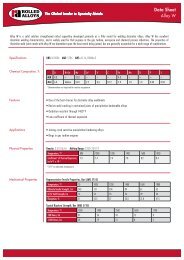
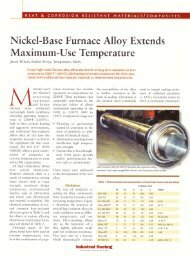
![RA333 Data Sheet [Heat Resistant Alloys] - Rolled Alloys](https://img.yumpu.com/50335849/1/190x245/ra333-data-sheet-heat-resistant-alloys-rolled-alloys.jpg?quality=85)
